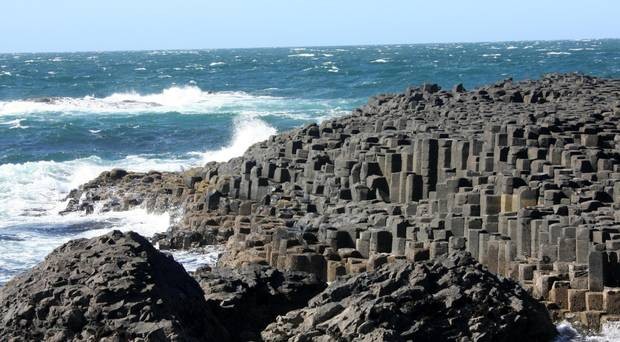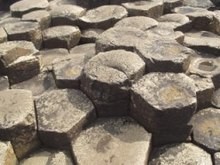Given the traditions and the geology it is not surprising that a myth about such a beautiful place developed.
The giant Fionn (Finn) appears in a few Irish myths and legends
The Irish giant Fionn mac Cumhall (Finn McCool), was at home with his wife Oonagh one day when a stranger arrived and delivered a challenge to Fionn to fight a Scottish giant variably known as Angus, Cu Challain or Benandona.
Fionn accepted the challenge and worked hard to build a causeway across the sea so that the two giants could meet.
One evening Fionn came home and Oonagh was looking anxiously at him. She had heard that the Scottish giant was much bigger than Fionn and was definitely stronger.
Fionn announced that if he couldn't beat the Scottish giant by strength, he would beat him by being clever.
Oonagh promptly set to work sewing big baby clothes, disguised Fionn as a baby and put him in a big cot. When the giant arrived, Oonagh invited him in and said that he must not wake the baby. When the giant saw how huge “the baby" was he thought how HUGE Fionn, the baby's father, must be.
The giant ran back to Scotland across the causeway in fright, destroying the Causeway behind him, picking up the stones and throwing them down in the sea so that Fionn would not be able to follow him. Only a few stones remained jutting out into the sea.
The Scottish giant never returned to Ireland.






 Blarney Castle and Gardens, County Corkon 06/01/2023
Blarney Castle and Gardens, County Corkon 06/01/2023
 An Cóbh, Corcaigh, Eireon 05/29/2023
An Cóbh, Corcaigh, Eireon 05/29/2023
 Dublin ; The Book of Kellson 04/04/2023
Dublin ; The Book of Kellson 04/04/2023
 The Bee Tree Community CIC;- an online support communityon 08/24/2022
The Bee Tree Community CIC;- an online support communityon 08/24/2022


Comments
The last entry to the second subheading, Irish mythical creatures, advises us of "Fear Dearg - a mischievous spirit like a leprechaun but dressed all in red."
Can the other mythical creatures be color-coded in terms of signature dress?
North America,
Thanks for taking the time to comment .
It is not just the spectacular geology and beauty, there is a spirituality there among the wild beauty.
I suspect that cluricauns were invented to explain the cause of the steady diminution of stocks in the wine cellar. That's my excuse and i'm sticking to it!
The natural beauty of this geographic formation is unmistakable. It is often featured in travel or nature-related television documentaries.
Ty Irish mythology is full of amusing and scary tales. I can always visualise them being told around the fire on dark, cold, bad weather nights.
This is quite a funny story :) Thank you so much for sharing! Also, as always, your comments and Frank's are fascinating.
Yes quite so. Folk lore in Ireland has remained an important tradition and feature. This I think comes about because of " yarning " which is when families gathered together before TVs and computers and told stories " yarning " by the fire . Love it !
Irish people treat sheogy places with respect. People are wary about disturbing a hawthorn. .
Great information on the Gaelic pronunciation . TY for the tips.
Another point about a sideog is that a place where the fairies are present is said to be sheogy. In England such places were said to be fey [hence Morgana le Fey.] Fairy forts are said to be sheogy. These are bronze age structures a bit small to be real forts, and are simply mounds,probably family dwellings. Certain spots are in local lore deemed sheogy.
A note on pronunciation and spelling. Sidhe is pronounced she as Irish does not pronounce median dentals [d, t, dh,th]. Hence Tuatha de Danaan is pronounced Tua. Atha is an Irish ending for a plural noun. A median dental is one of these sounds in the middle of a word.